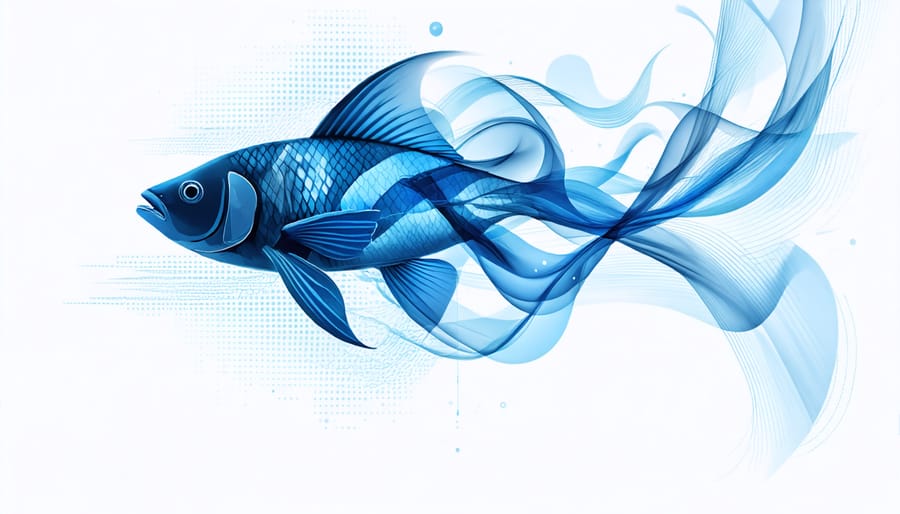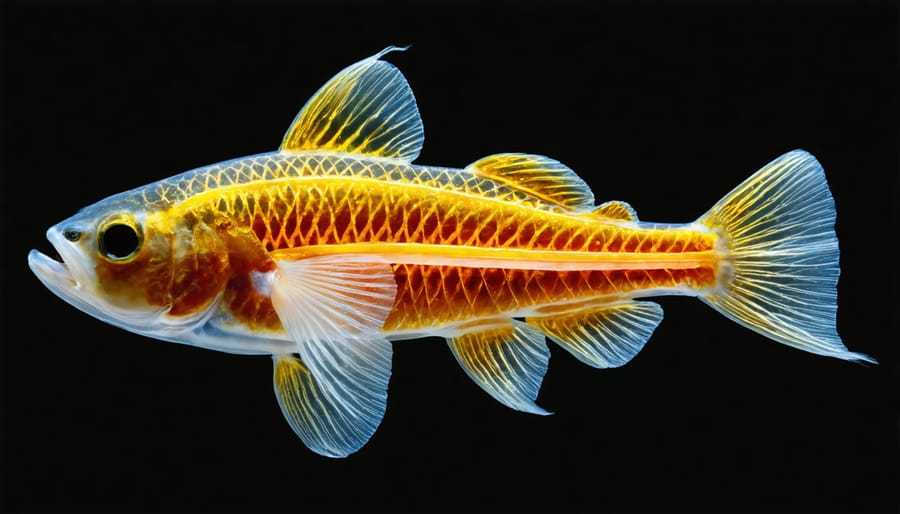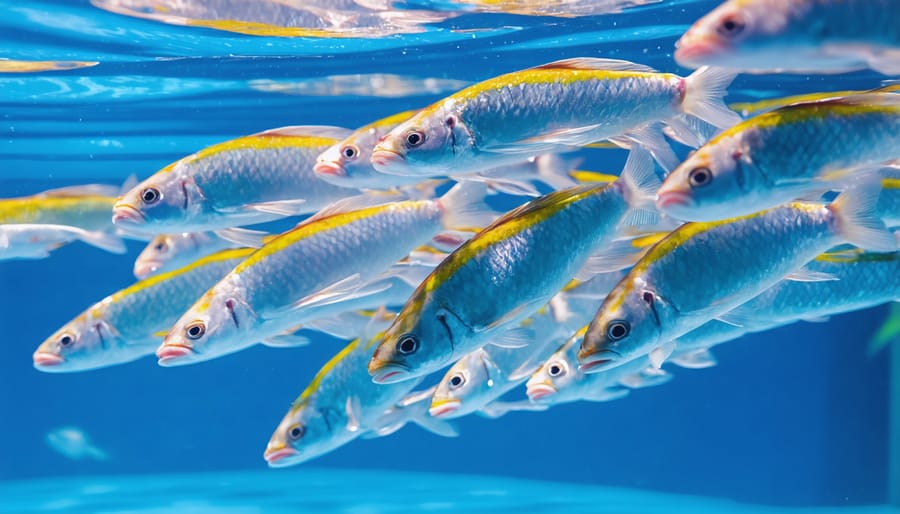
The boundless ocean holds secrets far beyond its mesmerizing surface, and within its depths lies a fascinating world of hydrodynamics that shapes every aspect of marine life. From the graceful movements of dolphins to the microscopic dance of plankton, water’s physical properties orchestrate an intricate ballet of survival, communication, and adaptation. Recent breakthroughs in hydrodynamics research have revolutionized our understanding of how marine organisms harness fluid dynamics to thrive in their aquatic environment, leading to groundbreaking applications in fields ranging from naval architecture to renewable energy.
As scientists delve deeper into the study of water movement and its interaction with marine life, they’re uncovering remarkable efficiency in nature’s design. Dolphins generate up to 90% less drag than human-engineered vessels of similar size, while schooling fish create complex vortex patterns that significantly reduce their collective energy expenditure. These discoveries not only illuminate the sophisticated mechanisms of marine life but also inspire innovative solutions for human challenges in fluid dynamics.
The convergence of advanced computational modeling, high-speed imaging, and biomimetic engineering has transformed hydrodynamics research from a purely theoretical pursuit into a dynamic field with immediate real-world applications. Whether improving the efficiency of ocean-going vessels, developing more effective underwater sensors, or designing better protective structures for coastal communities, the principles revealed through hydrodynamics research continue to bridge the gap between natural innovation and human ingenuity.
The Science Behind Hydrodynamic Signals
Water Flow Patterns and Information Transfer
Water movement patterns play a crucial role in how marine life communicates and interacts within aquatic environments. These patterns create complex networks of information transfer that marine organisms have evolved to interpret and utilize. Just as marine mammals use sound to navigate and communicate, many species rely on hydrodynamic signals to detect prey, avoid predators, and interact with their environment.
Water flow patterns can be categorized into three main types: laminar flow, which moves in smooth, parallel layers; turbulent flow, characterized by irregular fluctuations and mixing; and vortex formations, which create rotating currents. Each pattern carries distinct information that marine organisms can interpret through specialized sensory organs.
Fish, for example, use their lateral line system to detect minute changes in water pressure and movement. This remarkable adaptation allows them to school effectively, locate prey, and respond to approaching predators. Similarly, jellyfish and other invertebrates can sense water displacement patterns to coordinate their movements and feeding behaviors.
Understanding these hydrodynamic communication channels is essential for marine conservation efforts. Human activities that disrupt natural water flow patterns can significantly impact marine life’s ability to communicate and navigate effectively. This knowledge helps inform protective measures for marine ecosystems and guides the development of marine protected areas where natural flow patterns remain undisturbed.

Sensory Organs for Detecting Water Movements
Nature has evolved remarkable adaptations for detecting water movements, with many marine organisms possessing sophisticated sensory organs. The lateral line system, found in fish and some amphibians, serves as a prime example of these specialized organs. This system consists of a network of fluid-filled canals running along the body’s length, containing sensitive hair cells that detect subtle changes in water pressure and movement.
These hair cells, known as mechanoreceptors, function similarly to those in the human inner ear. When water movements disturb the gelatinous cupula covering these cells, they bend and trigger nerve impulses, allowing the animal to detect nearby movements with extraordinary precision. This system enables fish to school effectively, locate prey, avoid predators, and navigate through complex underwater environments, even in complete darkness.
Beyond the lateral line, many marine creatures possess additional mechanoreceptors distributed across their bodies. Sharks, for instance, have specialized organs called ampullae of Lorenzini, which can detect minute electrical fields generated by other organisms’ muscle movements. These electroreceptors work in conjunction with their mechanoreceptors to create a comprehensive awareness of their surroundings.
Marine mammals like seals and whales utilize specialized whiskers (vibrissae) that can detect even the faintest water movements, helping them track prey through the water column. These adaptations demonstrate the remarkable diversity of solutions that evolution has produced for sensing hydrodynamic information in aquatic environments.

Communication Strategies in Different Species
Fish Social Networks
Fish schools demonstrate remarkable coordination through sophisticated hydrodynamic social networks, utilizing water movements to maintain formation and communicate with group members. Similar to coral reef fish communication, schooling species have evolved intricate systems for sharing information through the water medium.
When fish swim, they create distinct vortices and pressure waves in the water, which neighboring fish can detect through their lateral line system – a specialized sensory organ that runs along their bodies. This remarkable adaptation allows them to perceive minute changes in water pressure and movement, enabling them to respond to their schoolmates’ actions almost instantaneously.
Research has shown that fish position themselves in formations that optimize both energy efficiency and information transfer. By swimming in specific patterns, they can reduce their collective energy expenditure by up to 20% while maintaining constant awareness of their companions’ movements and intentions.
The social network within a school operates like a living internet, with each fish acting as both a sender and receiver of hydrodynamic signals. When a fish detects danger or food, the information ripples through the school via changes in swimming patterns, creating a cascade of coordinated responses that can involve hundreds or even thousands of individuals within seconds.
Understanding these hydrodynamic social networks has important implications for marine conservation, as it helps us protect not just individual species but the complex behavioral systems that enable their survival.

Predator-Prey Interactions
In the vast underwater realm, predator-prey interactions are intricately linked to hydrodynamic signals, creating a complex dance of survival. Marine organisms have evolved remarkable abilities to detect and interpret water movements, which play a crucial role in their hunting and escape behaviors, similar to other deep-sea survival strategies.
Predators like sharks and dolphins utilize their sensitive lateral lines to detect the minute pressure changes and water disturbances created by potential prey. These hydrodynamic signatures, often called “flow fields,” can reveal the location, size, and even swimming patterns of prey species from considerable distances. Some predators have developed specialized hunting techniques that minimize their own hydrodynamic signals while maximizing their ability to detect those of their prey.
On the defensive side, prey species have evolved equally sophisticated mechanisms to detect and evade predators. Copepods, tiny marine crustaceans, can sense approaching predators through hydrodynamic disturbances and execute rapid escape maneuvers within milliseconds. This remarkable sensitivity allows them to detect threats from several body lengths away, giving them crucial extra moments to escape.
Understanding these hydrodynamic interactions has profound implications for marine conservation efforts. By studying how various species utilize water movements for survival, researchers can better predict how changes in water conditions might affect marine ecosystems and develop more effective conservation strategies.
Mating and Territory Defense
Many marine organisms utilize sophisticated hydrodynamic signals for mating rituals and territorial defense. During courtship, male dolphins create complex patterns of water movement through precise body movements and tail flicks, generating distinct pressure waves that female dolphins can detect from considerable distances. These underwater signatures serve as a form of communication, conveying information about the male’s fitness and reproductive readiness.
In coral reef environments, territorial fish species demonstrate remarkable mastery of water dynamics. Damselfish, for example, create deliberate water disturbances by rapid swimming movements to warn intruders of their territory boundaries. These hydrodynamic signals are particularly effective in the dense underwater environment where visual cues might be limited.
Research has shown that some marine invertebrates also employ hydrodynamic signals during reproduction. Male horseshoe crabs create specific water flow patterns to guide females toward nesting sites during breeding seasons. Similarly, certain species of sea horses generate localized currents through specialized fin movements to synchronize their mating dances.
Scientists studying these behaviors often use advanced flow visualization techniques and particle tracking systems to understand the precise mechanics of these water movements. This research has revealed that many species can detect and interpret water disturbances from potential mates or rivals at distances far greater than previously thought, highlighting the sophisticated nature of underwater communication systems.
Environmental Challenges and Adaptations
Impact of Ocean Currents
Ocean currents play a crucial role in how marine life communicates and navigates through vast underwater environments. These natural water movements create complex patterns that marine organisms have evolved to interpret and utilize, making them essential to understanding marine navigation techniques.
Large-scale ocean currents, such as the Gulf Stream and the Kuroshio Current, transport not only heat and nutrients but also acoustic signals across great distances. These underwater “highways” can enhance or diminish sound propagation, affecting how marine mammals communicate with their pods across vast oceanic expanses.
The interaction between currents and underwater topography creates distinctive sound signatures that many species use as acoustic landmarks. For instance, when currents flow past seamounts or through narrow channels, they generate unique vibrations and pressure patterns that whales and dolphins can detect and use for orientation.
Smaller-scale current patterns, including eddies and upwellings, also influence local communication conditions. These dynamic water movements can create acoustic shadows or channels that marine life adapts to, often adjusting their communication strategies based on current conditions.
Understanding these current-communication relationships has become increasingly important for marine conservation efforts, particularly as climate change alters traditional current patterns. Scientists are now working to predict how shifts in ocean circulation might affect marine species’ ability to communicate, navigate, and ultimately survive in changing seas.
Human-Made Disruptions
Human activities in marine environments increasingly disrupt the delicate hydrodynamic communication systems that aquatic organisms rely on. Marine noise pollution, primarily from shipping vessels, offshore construction, and seismic surveys, creates pressure waves that interfere with the natural flow patterns organisms use to detect prey, avoid predators, and communicate with one another.
Large vessels generate significant wake patterns and turbulence that can persist for hours, disrupting the subtle hydrodynamic signals many marine creatures depend on. These disturbances are particularly problematic in coastal areas and shipping lanes, where marine traffic is constant. Scientists have observed that schooling fish often display confused behavior and scattered formations when exposed to these artificial flow patterns.
Research has shown that propeller cavitation – the formation and collapse of air bubbles created by ship propellers – produces both acoustic and hydrodynamic disturbances that can mask important environmental cues. For example, harbor seals, which use their sensitive whiskers to detect prey movements, show reduced hunting success in areas with heavy vessel traffic.
Conservation efforts are now focusing on developing quieter ship designs and establishing marine protected areas where vessel traffic is limited. Some ports have implemented speed restrictions and alternative routing to minimize impact on sensitive marine habitats. These measures, combined with advancing research in marine acoustics and hydrodynamics, offer hope for better protecting marine life from human-made disruptions to their essential communication channels.
Current Research and Conservation Implications
Current hydrodynamics research is revolutionizing our understanding of marine ecosystems and providing crucial insights for conservation efforts. Scientists are using advanced flow visualization techniques and computational modeling to study how climate change affects ocean currents and marine life behavior. These studies are particularly focused on coral reef systems, where water movement patterns directly impact larvae distribution and reef health.
Recent research projects have revealed how changes in ocean currents influence the migration patterns of endangered species and the distribution of marine pollutants. This knowledge is proving invaluable for designing more effective marine protected areas and developing strategies to minimize human impact on sensitive marine environments.
Citizen science initiatives are playing an increasingly important role in this field. Marine biologists like Dr. Sarah Chen, who leads the Pacific Coast Hydrodynamics Project, emphasizes the importance of community involvement: “Understanding water movement patterns helps us predict where marine debris will accumulate and how to better protect vulnerable species.”
The applications of this research extend to artificial reef design and coastal restoration projects. Scientists are using hydrodynamic principles to create structures that optimize water flow for marine life while protecting coastlines from erosion. These innovations are particularly crucial as coastal communities face rising sea levels and increasing storm intensity.
Conservation groups are now incorporating hydrodynamics data into their protection strategies, leading to more effective marine sanctuary designs and improved understanding of species connectivity across ocean regions.
Understanding hydrodynamic communication in marine ecosystems is crucial for effective conservation efforts. Our research reveals the intricate ways marine organisms use water movements to interact, navigate, and survive. This knowledge helps us better protect vulnerable species and their habitats, particularly in areas affected by human activities and climate change.
By studying how marine life depends on hydrodynamic signals, we can develop more effective marine protected areas and implement policies that minimize disruption to these essential communication channels. For instance, understanding how ship traffic affects hydrodynamic signals helps us establish safer shipping routes that preserve marine animals’ ability to communicate and navigate.
The future of marine conservation relies heavily on our ability to comprehend and protect these invisible but vital communication networks. Through continued research and public awareness, we can work together to ensure marine ecosystems remain healthy and resilient. Whether you’re a scientist, conservationist, or concerned citizen, your involvement in marine conservation efforts makes a difference.
Remember, every action we take to protect marine environments helps preserve these remarkable communication systems that have evolved over millions of years. Let’s work together to safeguard these extraordinary underwater networks for future generations.
jessica
Ava Singh is an environmental writer and marine sustainability advocate with a deep commitment to protecting the world's oceans and coastal communities. With a background in environmental policy and a passion for storytelling, Ava brings complex topics to life through clear, engaging content that educates and empowers readers. At the Marine Biodiversity & Sustainability Learning Center, Ava focuses on sharing impactful stories about community engagement, policy innovations, and conservation strategies. Her writing bridges the gap between science and the public, encouraging people to take part in preserving marine biodiversity. When she’s not writing, Ava collaborates with local initiatives to promote eco-conscious living and sustainable development, ensuring her work makes a difference both on the page and in the real world.
